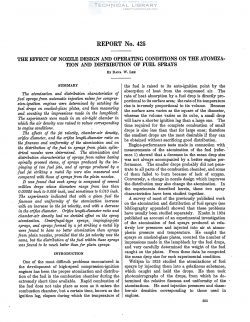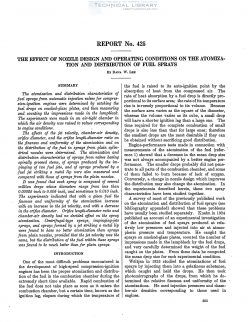naca-report-425

- Version
- 149 Downloads
- 1.65 MB File Size
- 1 File Count
- August 26, 2016 Create Date
- August 26, 2016 Last Updated
National Advisory Committee for Aeronautics, Report - The Effect of Nozzle Design and Operating Conditions on the Atomization and Distribution of Fuel Sprays

The atomization and distribution characteristics of
fuel sprays from automatic injection valves for compres-
siomignition engines were determined by catching the
fuel drops on smoked-glass plates, and then measuring
and counting the impressions made in the lampblaclc.
The experiments were made in an air—tight chamber in
which the air density was raised to values corresponding
to engine conditions.
The effects of the jet velocity, chamber—air density,
orifice diameter, and the orifice length-diameter ratio on
the fineness and uniformity of the atomization and on
the distribution of the fuel in sprays from plain cylin-
drical nozzles were determined. The atomization and
distribution characteristics of sprays from valves having
spirally grooved stems, of sprays produced by the im-
pinging of two fuel jets, and of sprays produced by a
fuel jet striking a metal lip were also measured and
compared with those of sprays from the plain nozzles.
It was found that each spray is composed of several
million drops whose diameters range from less than
0.00025 inch to 0.005 inch,'and sometimes to 0.010 inch.
The experiments indicated that with a given fuel the
fineness and uniformity of the atomization increase
with an increase in the jet velocity, and with a decrease
in the orifice diameter. Orifice length-diameter ratio and
chamber—air density had no decided eject on the spray
atomization. Centrifugal-type sprays, impinging—jets
sprays, and sprays formed by a jet striking a metal lip
were found to have no better atomization than sprays
from plain nozzles, provided that the jet velocity was the
same, but the distribution of the fuel within these sprays
was found to be much better than for plain sprays.
One of the most difficult problems encountered in
the development of high-speed compression-ignition
engines has been the proper atomization and distribu—
tion of the fuel in the combustion chamber during the
extremely short time available.
| File | Action |
|---|---|
| naca-report-425 The Effect of Nozzle Design and Operating Conditions on the Atomization and Distribution of Fuel Sprays.pdf | Download |

Comment On This Post